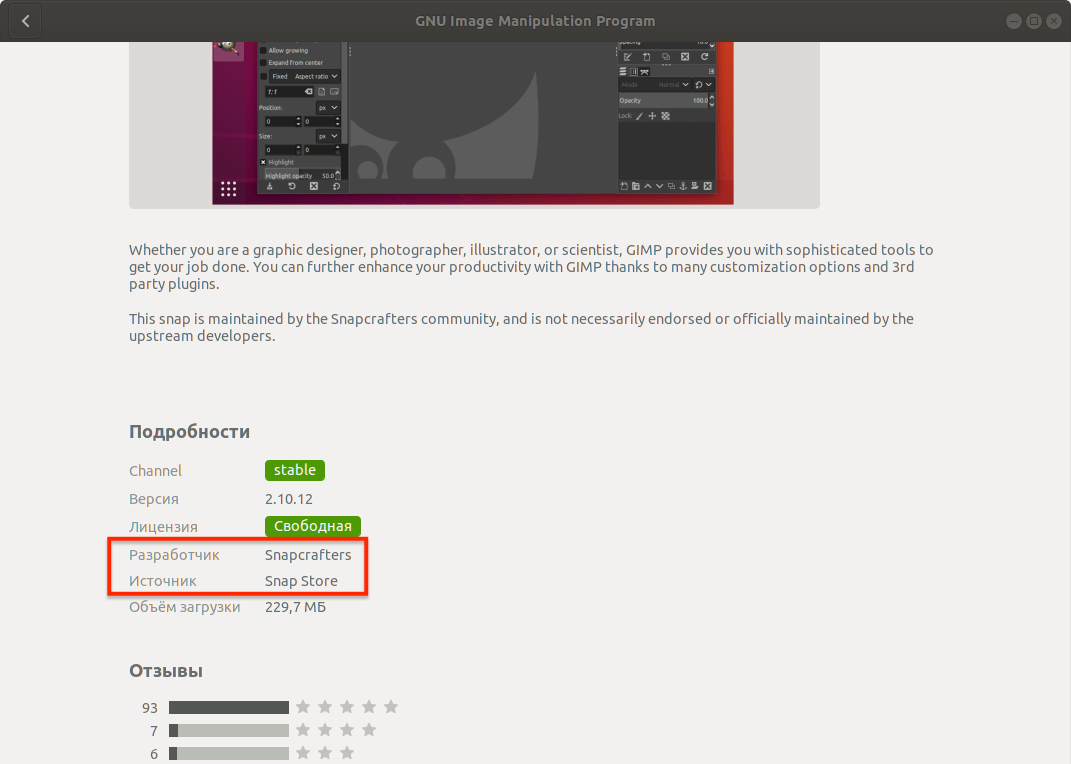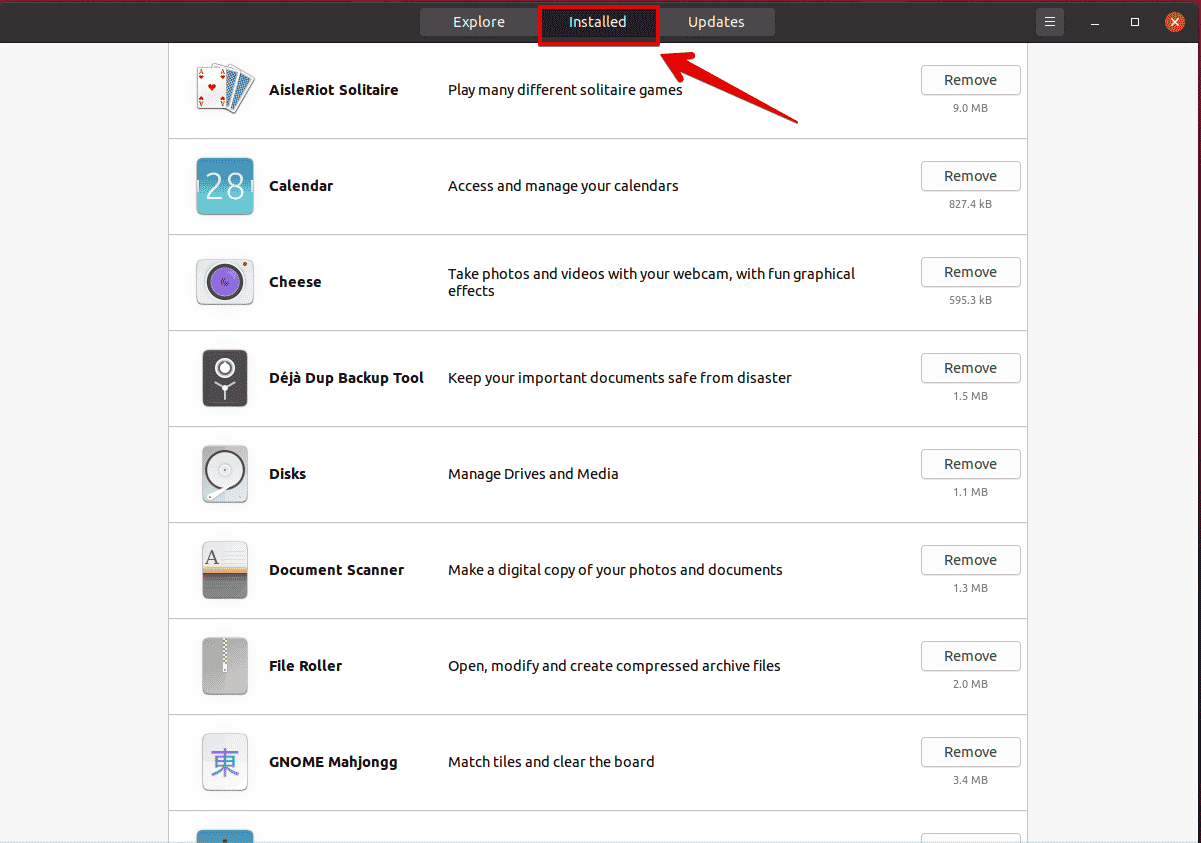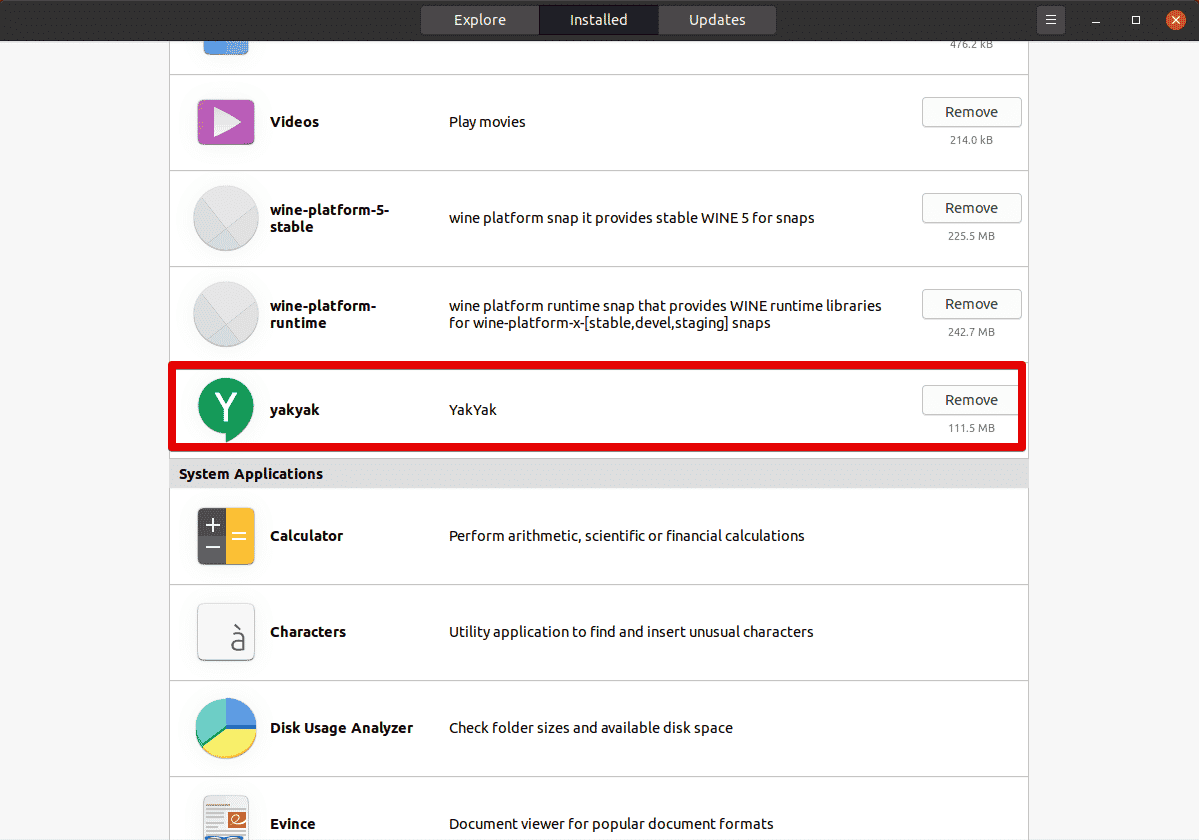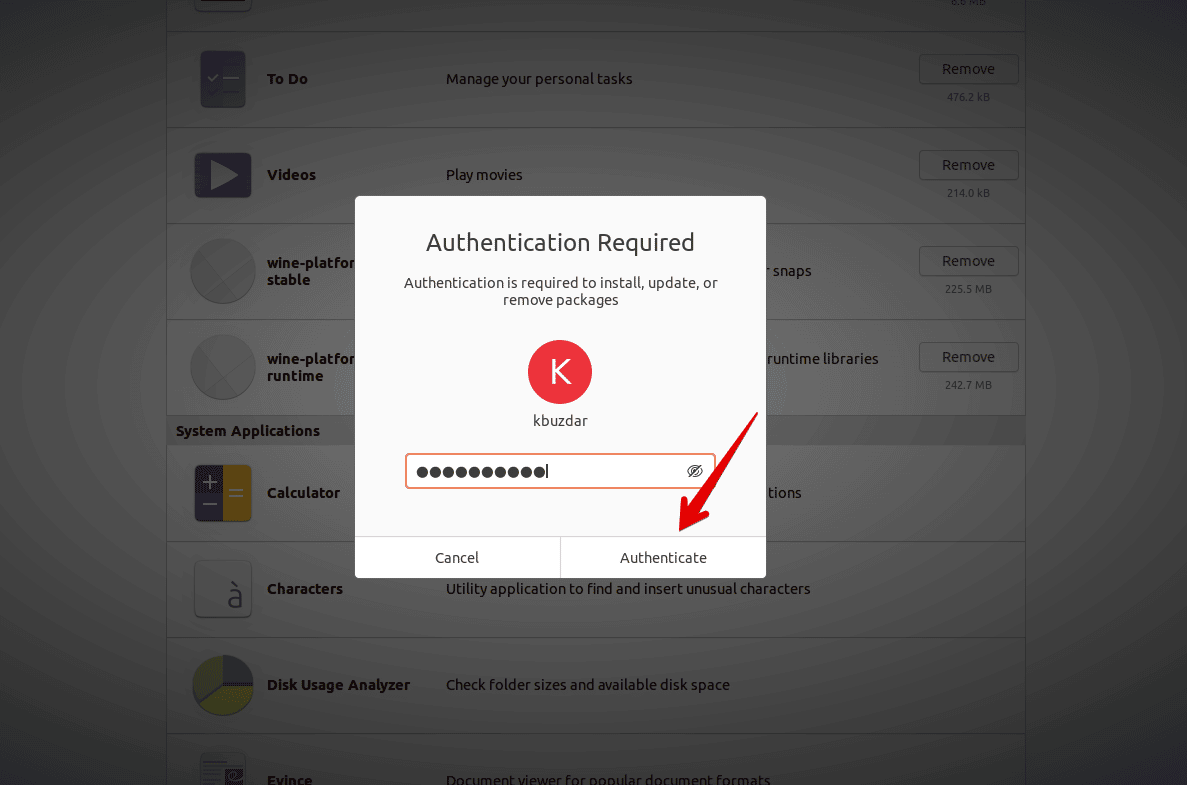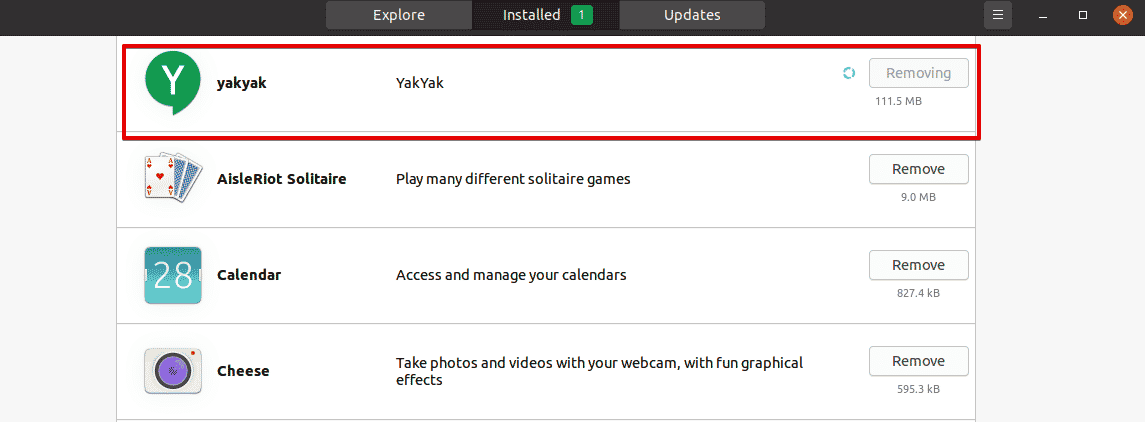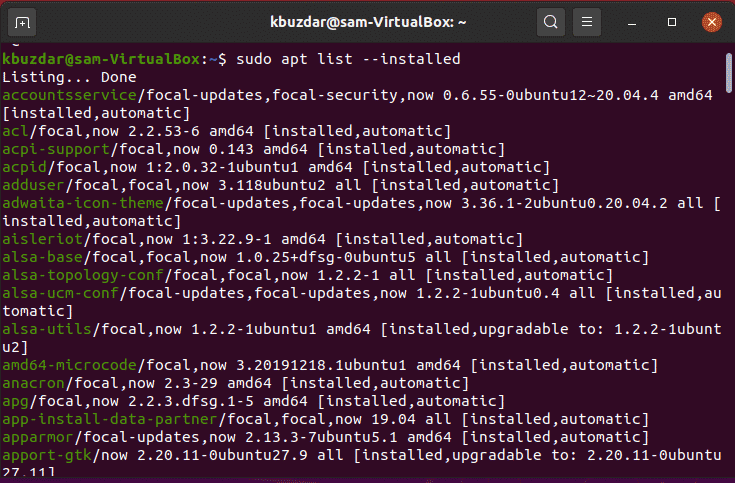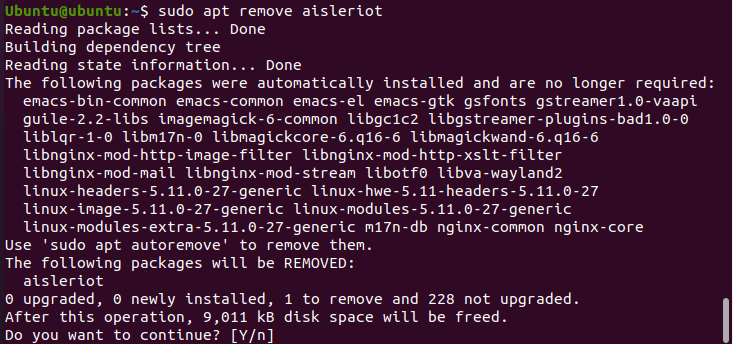How to delete program ubuntu
How to delete program ubuntu
3 Best Ways to Uninstall Software on Ubuntu
Uninstallation of programs can be done by graphical way using the Ubuntu Software Center, and the Synaptic Package manager. Command-line way of doing it is also possible using apt-get and aptitude commands. We shall discuss each one of them in detail.
T oday, let’s discuss all the possible ways to uninstall programs on your Ubuntu system. The methods we are going to show include graphical way as well as the command-line way, and both the methods will altogether remove the applications without leaving any trace.
Let’s start with the graphical way using the Ubuntu Software Center, and the Synaptic Package manager, followed by the command-line way via Terminal.
Uninstall Applications using Ubuntu Software Center
Step 1) Launch “Ubuntu Software.”

Step 2) On the Ubuntu Software Center, click on the “Installed” tab. It is the location to find all the installed applications.

Step 3) Scroll through the Applications and click on the “Remove” button next to the application. In the below example, I’m uninstalling the Amazon app on Ubuntu 19.04 system.

Step 4) Confirm the removal of the program. You should also enter the root password when prompted.

That’s it; the software should be uninstalled from your computer.
Uninstall Programs using Synaptic Package Manager
Synaptic Package Manager is an APT-based graphical package management tool. It serves as a graphical front-end to APT and is used to install, remove, and upgrade packages on the Ubuntu system. Synaptic package manager lists every program installed on your Ubuntu system. It includes libraries and system apps. It is equivalent to the command-line way, except you get an easy to use user interface.
Let’s begin with installing Synaptic Package Manager.
Step 1) Launch Terminal.

Step 2) Enter the following command and press enter.

Step 3) Install synaptic.

Step 4) Launch Synaptic Package Manager.

Step 5) Click on the “Search” icon on the top right corner of the Synaptic window. Look for the program that you want to uninstall and click “Search.”

Step 6) Right-click on the item and select “Mark for Complete Removal.”

Step 7) At this point, the uninstallation is not executed. It’s just added to the line. You can similarly add more apps for uninstallation. It will populate in the list. When you are done, click on “Apply.”

Step 8) Confirm by clicking on “Apply.”

Step 9) The program(s) should be uninstalled.

Uninstall Software on Ubuntu using Command-line
There are plenty of ways to remove the programs using command-line from the Terminal. I will discuss a few quite effective methods.
apt-get command:
The general syntax of using apt-get to remove the program is as follows:
You will have to know the package name. To determine the package name, use the dpkg command.
You should see a big list of applications. For example, I want to remove VLC Media Player, which is listed as just ‘vlc.’

Therefore, the command I should use is as follows:
Complete Uninstallation:
Additionally, use –purge command to completely uninstall the app if you plan not to reinstall the app.
Bonus: Using aptitude command
There is yet another way to remove the program using aptitude. Aptitude command automatically removes everything and provides an interactive command line interface.
Aptitude is not installed in Ubuntu by default, so first, you need to install it.
sudo apt-get install aptitude
Then to uninstall a package using aptitude, use the following command format:
For example, I have removed the ‘deluge’ application in Ubuntu.

Удаление программ в Ubuntu
Программы, игры, утилиты и другие программные компоненты в операционной системе Ubuntu представлены в виде пакетов. Когда вы устанавливаете какую-нибудь программу (приложение), вы устанавливаете один или несколько пакетов.
Рассмотрим, как удалять приложения (пакеты) в Ubuntu.
Существует два основных способа удаления пакетов в Ubuntu: использование Менеджера приложений Ubuntu (Ubuntu Software Center) и использование командной строки.
Удаление программ, используя Менеджер приложений
Рассмотрим самый простой способ удаления пакетов в Ubuntu — использование Менеджера приложений.
Запустите Менеджер приложений Ubuntu. Для этого откройте лаунчер, нажав сочетание клавиш Super+A (клавиша Super на клавиатурах Windows соответствует клавише Win ). В лаунчере запустите программу Менеджер приложений.
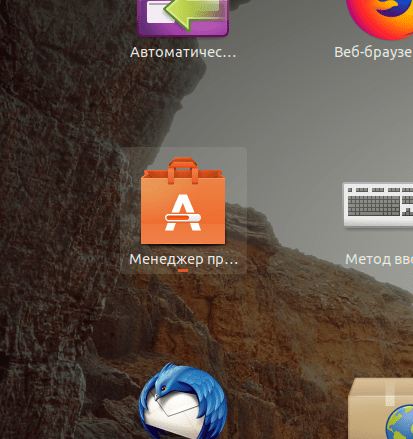
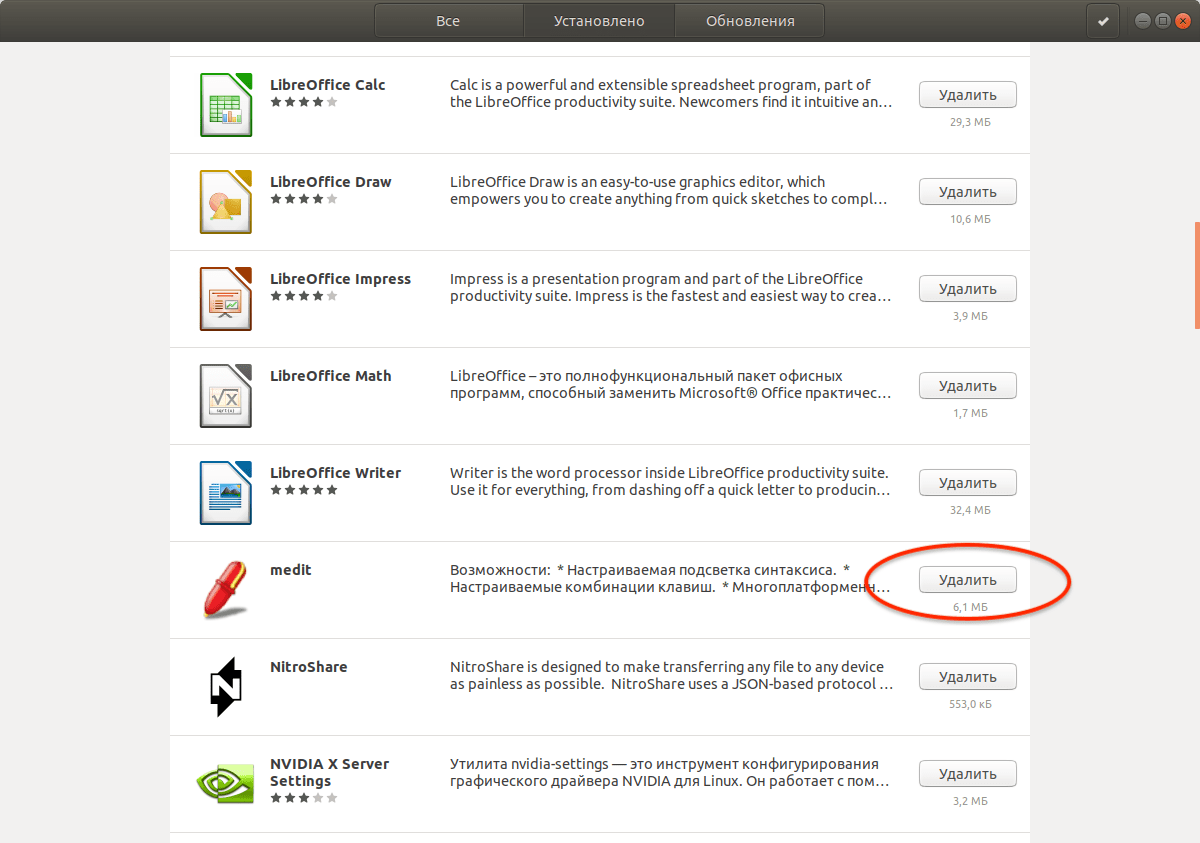

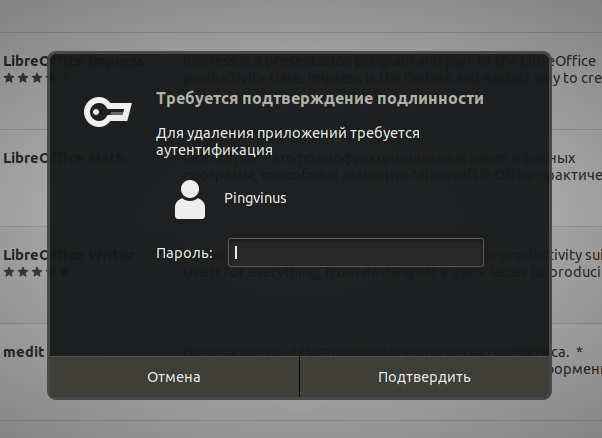
Удаление программ, используя командную строку
Второй распространенный способ удаления программ — это использование командной строки.
Для управления пакетами в Ubuntu используются утилиты командной строки apt и apt-get. Они имеют схожий синтаксис. Для новичков рекомендуем использовать утилиту apt. Смотрите также наше руководство: «Использование APT. Команды apt и apt-get».
Чтобы удалить пакет, выполните следующую команду (вместо имяпакета необходимо указать настоящее название пакета):
Например, чтобы удалить программу GIMP необходимо выполнить команду:
Чтобы полностью удалить пакет и его конфигурационные файлы используется команда:
Чтобы удалить сразу несколько пакетов можно указать их названия через пробел:
Чтобы вывести список всех установленных пакетов используется команда:
Удаление Snap пакетов
В Ubuntu есть пакеты, которые отличаются от обычных — это Snap пакеты. Подробнее про Snap пакеты вы можете прочитать в нашей статье «Snap-пакеты в Linux. Что это и как с ними работать»
Вы можете удалить Snap пакеты точно также как и любые другие через Центр приложений Ubuntu. В Менеджере приложений Ubuntu для snap-пакетов указан источник «Snap Store». Обращаем ваше внимание на то, что в списке приложений могут присутствовать программы, которые могут быть установлены через обычные репозитории Ubuntu, так и через Snap. Обычно такие приложения имеют разные версии. Приложения, распространяемые через Snap, как правило, всегда новее.
Рассмотрим, как удалять приложения, установленные через Snap, используя командную строку.
Чтобы вывести список установленных Snap пакетов выполните команду:
Для удаления Snap пакета выполните команду:
Удаление неиспользуемых пакетов
Когда вы устанавливаете какую либо программу, то обычно помимо основного пакета программы устанавливаются еще другие пакеты, которые требуются для работы данной программы. Они называются зависимостями.
После удаления программы, зависимости не удаляются. Они могут вообще не использоваться в системе или использоваться другими программами. Если пакеты-зависимости не используются другими программами, то такие пакеты можно удалить, чтобы они не занимали место в системе.
Для удаления неиспользуемых пакетов используется команда:
Данная команда автоматически удалит неиспользуемые пакеты.
Заключение
Мы рассмотрели различные способы удаления программ в Ubuntu. В большинстве случаев для удаления программ можно пользоваться Менеджером приложений Ubuntu. Использование командной строки дает дополнительные возможности и зачастую работать через нее быстрее.
How to completely uninstall applications by command line in Ubuntu
Uninstall Ubuntu Software and clean-up obsolete dependencies
U ninstalling the software from the command line via Terminal is one of the most important tasks while dealing with troubleshooting a remotely connected Ubuntu PC. In today’s Terminal Tuts session, let’s take a deep dive into it.
Uninstalling Software from Terminal in Ubuntu
The following guide is tested on Ubuntu 17.10 but should work on older Ubuntu versions as well as Linux Mint, and elementary OS.
Step 1) To uninstall a software package, you need to know the exact name of it. We shall use the tdpkg list command for it. Launch ‘Terminal’ and enter the following command:
You should see a long list of applications. Note down the name of the program which you want to uninstall. For example, I want to remove VLC Media Player, which is listed as just ‘vlc’.

Step 2) To uninstall a program, we shall use remove command along with apt-get, which is typically used to install applications. Of course, sudo command to carry out superuser tasks. There are two important things to consider on what’s your uninstallation plan.
Keep Personalized Settings:
If you are removing a program only to reinstall later, then you may want to keep the configuration files, which will remember your settings applied in that app. In such a case, use the remove command as follows:
In my case, to remove vlc:
Complete Uninstallation:
On the other hand, use –purge command to completely uninstall the app if you plan not to reinstall the app.
Some Housekeeping
Now that you have uninstalled the software, you may want to do some extra cleanup to remove the dependencies of the software you uninstalled now or may be in the past. Dependencies are the apps and libraries that are used by the software you no longer have in your PC. Note that it is entirely safe to do so because no application is using them.
As you see autoremove command is generic cleaning command for any obsolete packages that are left over in your PC.
How to uninstall programs from Ubuntu 20.04 LTS
Most of the time, you need to uninstall or remove the programs or applications from your system that are not under-used and you can make extra space there. For this purpose, you must know how to get rid of uninstalling unnecessary applications or programs from your system. This article will give you a demo about how to uninstall software applications from your Ubuntu system 20.04 system.
Prerequisites
You must have administrative or root privileges in order to remove or uninstall a software application from your system.
You can uninstall a program in Ubuntu 20.04 using two different ways:
Uninstall a program using Ubuntu Software Manager
Using this method, you can easily uninstall a package from your system through the Ubuntu Software Manager. To do that, click on the Ubuntu Software application icon under the ‘Activities’ toolbar as follows:
The window of the Ubuntu software manager will open on your computer through which you can install or uninstall the specific packages on your system.
Click on the installed tab where you will see the list of applications.
Now, from the whole list select a package that you want to remove or uninstall from your system and then click on the remove button.
Let’s take an example, we want to remove the ‘yakyak’ application from your Ubuntu 20.04 system. For this purpose, scroll down the whole list and select this application from the list and click on the ‘Remove’ button to uninstall this package.
The confirmation dialog will appear on the system where you will click on ‘Remove’.
In the next prompt, it will ask you to enter the administrative password.
After that, you will see that the selected package is removed.
Uninstall Packages using the command line
You can easily remove or uninstall software by using the command line. So, it is recommended that list all packages that are installed by using the following command:
After executing the above command, you will see the all packages list that installed on your computer. Now, by using the following commands you can easily remove or uninstall a specific package from your system:
Remove a software package using the apt remove command
The apt remove command is used to remove or uninstall a specific package from your system. This command keeps the all configuration files settings even if you removed a specified package. So, if you want to reinstall this package again in the future then you can do it. Let’s take an example, you want to uninstall a package ‘snapd’ from the system.
Follow the following basic syntax of apt remove command which is given below:
When you try to remove a package from your system, a confirmation prompt will be displayed on your system that will ask you to enter ‘Y’ to confirm the procedure. In a while, the specified package will be removed from your system.
Uninstall package using the apt purge command
Using the apt purge command, you can remove a specific package from your system along with its all configuration settings.
Similarly, you can also remove package dependencies by using the following command:
Conclusion
From the above article, we have seen how to uninstall a program from your system by using two different methods in Ubuntu 20.04 system. The first method is using a graphical software manager and the other is how to uninstall packages using the command line.
Samreena Aslam holds a master’s degree in Software Engineering. She’s a technical writer and has written various articles on different Linux flavours including Ubuntu, Debian, CentOS and Mint.
How to Uninstall Software On Ubuntu
We all know that Ubuntu and other Linux distros are different from the commonly used Windows. Users migrating from Windows to Ubuntu can find it hard navigating even the basic stuff. Uninstalling software can be tricky, so this article will help you understand the different ways you can bin software in Ubuntu.
Just like installing software can be done in two ways, i.e., through the Terminal or using the GUI, uninstalling software can be done using either of them. There are three main types of software packages that are installed on Ubuntu and are listed as follows
Native packages or Debian packages are the packages found in and can be added to Ubuntu’s repository. These packages are only available for Debian-based distributions, including Ubuntu. To accommodate other distros, Snap and Flatpak packages were introduced. These packages can be run and executed in all Linux distros.
Method 1: Uninstall Software Using Ubuntu Software Center
If you prefer performing tasks graphically, you can use the “Ubuntu Software Center” application to uninstall software. It is a relatively straightforward and easy way to get rid of applications. Ubuntu Software Center also gives you the privilege to uninstall all the Native, Snap, and Flatpak packages available to you in Ubuntu.
The process of uninstalling software using Ubuntu Software is also pretty similar to uninstalling applications on Windows. So, Ubuntu users who have just started, Ubuntu Software is the best go-to way. Follow these steps.
1. Press the “System (Windows)” key, and in the search bar, type “Ubuntu Software.” You should see this icon in the results. Click on it to open it up.

2. Once you have opened Ubuntu Software, go to the “installed” tab located at the top. This will take you to the section where all your installed apps are listed.

3. Scroll through the list to find the app that you desire to uninstall. When you find your desired app, click the remove button to start the uninstallation process.
4. You will be asked to enter your account password once you click the remove button to proceed with the uninstallation. This process will be repeated for every app you want to remove.
Method 2: Uninstall Software Using Terminal
As mentioned before, the second method to uninstall apps and software is through the famous Linux command “Terminal”. The terminal is best for users who prefer a much more hands-on experience while using their computer systems. To uninstall applications, you need to know the commands and the name of the app you will uninstall.
Unlike Ubuntu Software, you can’t uninstall native apps, Snap packages, and Flatpaks with a single command. There are different commands for different packages. The following steps will guide you on uninstalling different software packages using the terminal.
Uninstalling Native Ubuntu apps using Terminal
1. To uninstall the apps from the terminal, open the Ubuntu terminal by pressing the “System (Windows)” key and type “Terminal” in the search box. You should see the icon for “Terminal”; click on it. You can also open the terminal by pressing “Ctrl + Alt + T” on your keyboard.

2. You can uninstall native apps, also known as Debian apps, by typing either of the following commands in the terminal.
3. If you are not sure what the exact name of the program is, search it from the available list. To search your application from the list of installed Debian apps, type the following command in the terminal

4. After finding the name, repeat step 2 to remove the software from your computer system.
Uninstall Snap packages using Terminal
Snap packages have become very popular because of their usability. To remove a specific Snap package, follow these steps.
1. If you don’t know the exact name of your Snap package, type the following command and search it from the list
2. Once you know the correct name of the Snap package you wish to remove from your system, type the following command in the terminal.
Uninstalling Flatpaks using Terminal
Although Flatpaks are not as popular as Snap packages, there are still a lot of Ubuntu users that use Flatpaks. Follow these steps to uninstall Flatpaks from your system.
1. If you are not sure what the exact name of your Flatpak is, type the following command and search your desired Flatpak from the list.
2. Once you have found your desired Flatpak, type the following command in the terminal to remove your desired flatpack from your system.
These are the different commands you can use to uninstall different app packages from your Ubuntu system.
Conclusion
This article went through the ways you can uninstall the software from your Ubuntu system. Ubuntu is an operating system that is quite powerful and unique in its usage. You can enjoy most of the functions through the GUI, but it is recommended that you learn to use the command terminal as it makes your computing experience unique while using Linux and its distros.
About the author
Zeeman Memon
Hi there! I’m a Software Engineer who loves to write about tech. You can reach out to me on LinkedIn.


